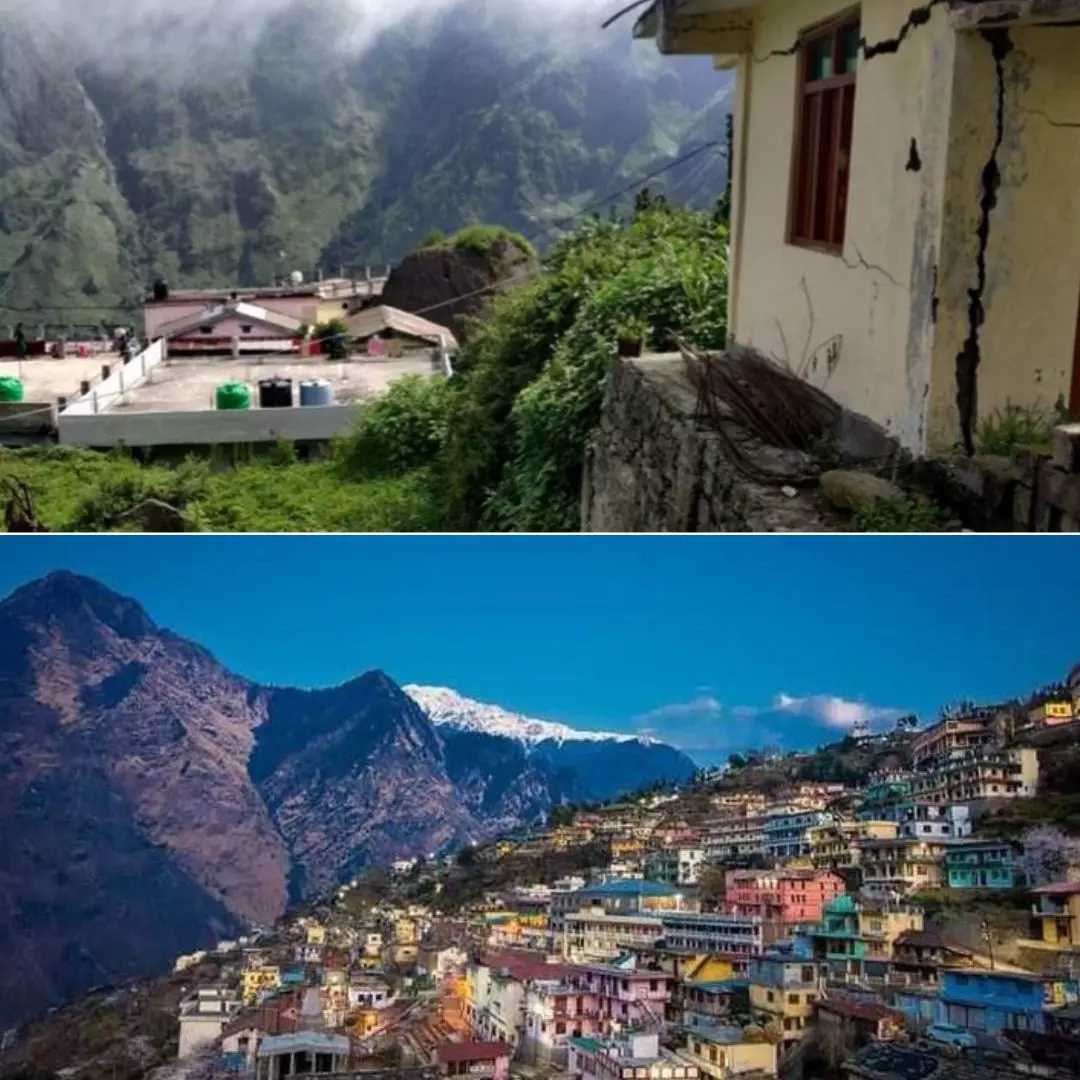
Image Credits: Twitter/@sdcfoundationuk, Char Dham Tours
Warnings Blared Since 1976: Here's How Joshimath Became 'Sinking Town' & Threatens Lives Of Thousands
Writer: Laxmi Mohan Kumar
She is an aspiring journalist in the process of learning and unlearning many things. Always up for discussions on everything from popular culture to politics.
Uttarakhand, 7 Jan 2023 9:05 AM GMT
Editor : Shiva Chaudhary |
A post-graduate in Journalism and Mass Communication with relevant skills, specialising in content editing & writing. I believe in the precise dissemination of information based on facts to the public.
Creatives : Laxmi Mohan Kumar
She is an aspiring journalist in the process of learning and unlearning many things. Always up for discussions on everything from popular culture to politics.
Right from the 1970s, many experts have studied the geography of Joshimath and expressed concern over the land's gradual subsidence. Four decades later, residents of the city live under the threat of being displaced as the city continues to sink.
With a temple collapsed, over 500 houses developing cracks, people left out in the cold, and the Uttarakhand Chief Minister Pushkar Singh Dhami ordering the immediate evacuation of 600 families, the "sinking town" of Joshimath has heightened fear among the residents. The town had made headlines recently with the Uttarakhand government banning further construction works in the sinking land and panicked locals protesting for a solution. Located at an altitude of 1890 metres in the Garwhal Himalayas, Joshimath is an important station for both pilgrim and trekking circuits.
With a population count of over 20,000, the town has visibly shown changes and its fragility over the years. Joshimath is the site of an ancient landslide, and the station's destruction was catalysed over the years with under-planned and indiscriminate developmental projects. Many experts have conducted surveys and revealed that the fear among residents was true - the city is sinking at its base. Even with the Chief Minister assuring that the situation is being closely monitored, there is more to the disaster waiting to unfold in Joshimath.
Very scary situation unfolding in #Joshimath. Massive cracks and fissures in almost all houses, major hotels and roads. More than 700 families are impacted. Leaning buildings across the town.
— Tanushree Pandey (@TanushreePande) January 6, 2023
Families tell me, "The govt knew everything since last year but never took any action." pic.twitter.com/G9SRvmG1kV
Why Is Joshimath Sinking?
The first ever report that pointed to the impending dangers lying ahead in Joshimath was a 1976 report by the government-appointed Mishra Commission. It conveyed the crucial piece of information that Joshimath is located on the site of an ancient landslide, and any form of unplanned construction could potentially dig up a grave for the town. It paved the way for many future studies that confirmed that the biggest reason contributing to Joshimath's sinking is the geography of the city.
In 1976, experts warned to stop developmental works in ecological fragile region of Joshimath, Uttarakhand. Today Joshimath is sinking. And thousands of people are now become homeless.
— Licypriya Kangujam (@LicypriyaK) January 7, 2023
When humans will stop ecological destruction ? You will pay the price to your children. pic.twitter.com/JfTjMa47GH
Geographically, a 2022 survey conducted by researchers from the Wadia Institute of Himalayan Geology found that the gneissic rocks in the region are highly weathered and have a tendency to high pore pressure when saturated with water, especially during monsoons. The impact of extreme rainfalls is often visible in satellite data, which shows mountain streams expanding their channels over the course and posing a threat of instability on the already fragile belt. Apart from the monsoons, there's also a good amount of erosion noticed with the running streams from Vishnuprayag flowing along the town.
Piyoosh Rautela, executive director of the Uttarakhand State Disaster Management Authority (USDMA), had once conveyed that the "Large boulders of gneisses and fragments of basics and schistose rocks are embedded in the grey-coloured, silty-sandy matrix. This makes the town highly vulnerable to sinking." All of this indicates that the region's land and soil have a very low capacity of being held together. Adding on to this, an earlier report from 2006 had observed that the drainage system of the town of Joshimath is not well maintained, placing the town at even more risk. Furthermore, the city built over landslide debris was found to have a low bearing capacity, and many experts have long warned that it cannot support a high rate of construction. According to a report by ABP Live, these warnings since 1976 were not paid much heed to, and for decades the town witnessed increased construction, hydroelectric projects, and widening of the National Highway, leading to an unstable slope.
Construction Projects Widening The Dent
While geographically, the town is at high-risk, many developmental projects made it a speedier process for the belt to lose its stability. Among the many projects that went under the scanner was the Char Dham Project and the hydropower project under the National Thermal Power Corporation.
Multiple media reports released at the time conveyed that Joshimath could not be saved unless many such projects were shelved. Hemant Dhyani, an environmentalist and member of the High Powered Committee (HPC) appointed by the Supreme Court to study the Char Dham Project, warned the officials of the geological vulnerability of the area. A report by the Economic Times suggests that despite warnings from the experts of potential ground subsidence in the region, no remedial measures were adopted, and today the town continues to sink.
For 26 months when I was Environment Minister, I grappled with the development-environment issue in Uttarakhand. In a vast majority of cases, I decided in favour of ecological protection. This didn't win me many friends, but these visuals from Joshimath vindicates my position. pic.twitter.com/4UYvgJJbiX
— Jairam Ramesh (@Jairam_Ramesh) January 7, 2023
What Next For Joshimath?
While the alarms have been going on for a long time, there's still hope for saving Joshimath if the proper measures are implemented. For starters, the residents would have to be relocated to a safer space, and the administration would have to replan the town in a manner that accommodates the changing geographical conditions of the town. Even more importantly, experts recommend a complete shutdown of the developmental and hydroelectric projects in the region until stability is brought back to the belt. They have instead suggested replantation, especially at the vulnerable sites, which would enable retaining the soil capacity. For the same, there is a need for coordinated efforts between the government, civil bodies, military organisations like the BRO, and the residents.
Also Read: Uttarakhand's Joshimath Sinking! Cracks Emerge In Over 500 Buildings, Expert Team Inspects The Town
 All section
All section














